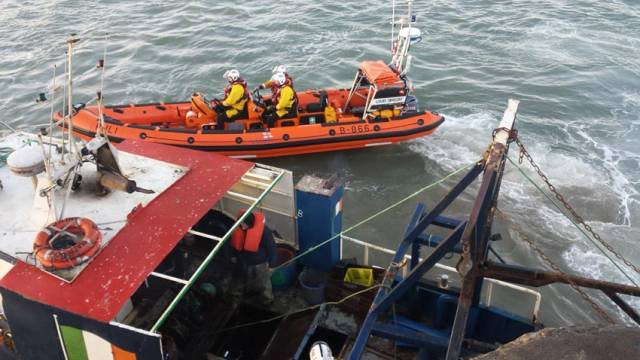#RNLI - Skerries RNLI responded to three calls for help since the weekend, bringing to safety three men, a woman – and a dog.
Dublin Coast Guard tasked Skerries RNLI shortly after 6.30am yesterday morning (Wednesday 1 March) after a call from a fishing vessel with two men on board that had run aground on the rocks south of Shenick Island.
The inshore lifeboat crew quickly located the fishing boat and determined that she was still aground, but not taking on any water.
As a precaution, Howth RNLI’s all-weather lifeboat was requested to assist, but as the vessel began to float no help was required and the Howth crew returned to station.
The Skerries lifeboat — with helm Eoin Grimes and crew Paddy Dillon, Steven Johnson and Peter Kennedy — stood by the fishing vessel as she returned safely to Skerries Harbour.
Two days previously, on Monday morning (27 February) shortly after 10.30 am, volunteers Conor Walsh, Joe May and Stephen Crowley manned the lifeboat to assist a woman who was stranded on the rocks after going to the aid of a trapped dog.
The woman was not the owner of the dog, but had waded out to help the distressed animal before being cut off by the tide.
Both were brought safely to the lifeboat station and the dog was taken to a local veterinarian, where she was later reunited with her owner.
On Saturday afternoon (25 February), the lifeboat was launched with Eoin Grimes, Conor Walsh and Simon Shiels on board after the coastguard requested assistance for a man who had lost power on his personal watercraft.
The man had been some way off shore when he ran into difficulty, and was exhausted after he had managed to paddle a long distance.
The lifeboat crew assisted the man ashore where he received further help from the Skerries Coast Guard unit. They then took the watercraft under tow and returned it to the beach.
Speaking about the callouts, Skerries RNLI lifeboat press officer Gerry Canning said: “We’re very proud of our volunteers. This last few days they have shown just how much commitment and dedication is involved in being on call 24 hours a day, 365 days a year. They are always ready to respond to a call for help.”
































































